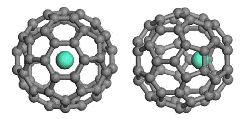Department of Chemistry
Date of this Version
10-5-2009
Abstract
We report improved results of lowest-lying silicon clusters Si31–Si38. A large population of low-energy clusters are collected from previous searches by several research groups and the binding energies of these clusters are computed using density-functional theory (DFT) methods. Best candidates (isomers with high binding energies) are identified from the screening calculations. Additional constrained search is then performed for the best candidates using the basin-hopping method combined with DFT geometry optimization. The obtained low-lying clusters are classified according to binding energies computed using either the Perdew–Burke–Ernzerhof (PBE) functional or the Becke exchange and Lee–Yang–Parr correlation (BLYP) functional. We propose to rank low-lying clusters according to the mean PBE/BLYP binding energies in view that the PBE functional tends to give greater binding energies for more compact clusters whereas the BLYP functional tends to give greater binding energies for less compact clusters or clusters composed of small-sized magic-number clusters. Except for Si30, the new search confirms again that medium-size silicon clusters Si31–Si38 constructed with proper fullerene cage motifs are most promising to be the lowest-energy structures.


Comments
Published in Physics Letters A 373:41 (October 5, 2009), pp. 3757–3760; doi: 10.1016/j.physleta.2009.08.009 Copyright © 2009 Elsevier B.V. Used by permission. http://www.elsevier.com/locate/pla